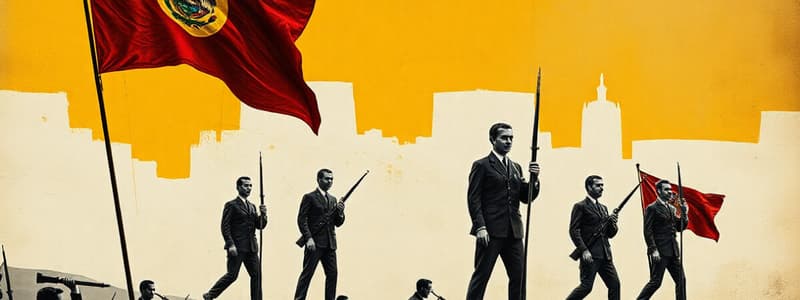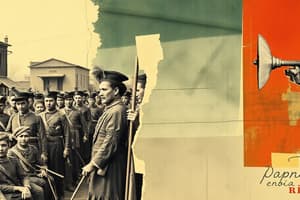Podcast
Questions and Answers
Who were the two soldiers that returned from Spain to aid in the War of Independence?
Who were the two soldiers that returned from Spain to aid in the War of Independence?
- Simón Bolívar and Emilio Aguinaldo
- José de San Martín and Carlos María de Alvear (correct)
- Miguel Hidalgo and José María Morelos
- Bernardo O'Higgins and Manuel Belgrano
The Second Triumvirate was aligned with the interests of the Morenista group.
The Second Triumvirate was aligned with the interests of the Morenista group.
False (B)
What was the purpose of the open town council in colonial times?
What was the purpose of the open town council in colonial times?
To discuss urgent issues or important matters with neighbors.
The political pressure group that emerged from the revolution is known as a _____?
The political pressure group that emerged from the revolution is known as a _____?
Match the following terms with their definitions:
Match the following terms with their definitions:
Who was the president of the First Junta?
Who was the president of the First Junta?
Mariano Moreno was in favor of a moderate approach towards Spain.
Mariano Moreno was in favor of a moderate approach towards Spain.
What event in 1811 indicated the loss of Upper Peru for the Patriots?
What event in 1811 indicated the loss of Upper Peru for the Patriots?
The _______ led by Juan José Castelli failed to gain support from powerful groups in Upper Peru.
The _______ led by Juan José Castelli failed to gain support from powerful groups in Upper Peru.
Match the following members with their roles in the First Junta:
Match the following members with their roles in the First Junta:
What caused the internal divisions within the First Junta?
What caused the internal divisions within the First Junta?
The members of the First Junta included the Bishop of Córdoba.
The members of the First Junta included the Bishop of Córdoba.
What was the outcome for Mariano Moreno after Saavedra's victory in 1811?
What was the outcome for Mariano Moreno after Saavedra's victory in 1811?
Who replaced Viceroy Baltasar Hidalgo de Cisneros on May 25, 1810?
Who replaced Viceroy Baltasar Hidalgo de Cisneros on May 25, 1810?
The First Junta was initially popular and widely accepted by all residents of Buenos Aires.
The First Junta was initially popular and widely accepted by all residents of Buenos Aires.
What central issue was pivotal during the war from 1810 to 1820?
What central issue was pivotal during the war from 1810 to 1820?
The junta governed in the name of ______, King of Spain.
The junta governed in the name of ______, King of Spain.
What event marked the beginning of the first period from the revolution of 1810 to 1814?
What event marked the beginning of the first period from the revolution of 1810 to 1814?
Match the following members of the First Junta with their roles:
Match the following members of the First Junta with their roles:
Between 1810 and 1820, the new government faced challenges and sent ______ expeditions to confirm its authority.
Between 1810 and 1820, the new government faced challenges and sent ______ expeditions to confirm its authority.
The changes in government between 1810 and 1814 were largely driven by violence and external wars.
The changes in government between 1810 and 1814 were largely driven by violence and external wars.
Flashcards
Vecino
Vecino
A Spanish resident of a city, who held the right to participate in the town council during colonial times.
Open town council
Open town council
Extraordinary meetings of the town council where non-members were invited to discuss important matters.
Faction
Faction
A group with political goals but lacking a clear set of doctrines or principles.
The English invasions
The English invasions
Signup and view all the flashcards
Professionalization of the army
Professionalization of the army
Signup and view all the flashcards
First Junta (1810-1811)
First Junta (1810-1811)
Signup and view all the flashcards
First Junta
First Junta
Signup and view all the flashcards
Radical faction (First Junta)
Radical faction (First Junta)
Signup and view all the flashcards
Moderate faction (First Junta)
Moderate faction (First Junta)
Signup and view all the flashcards
Junta Grande (1811)
Junta Grande (1811)
Signup and view all the flashcards
Coup d'état
Coup d'état
Signup and view all the flashcards
Executive power taken from the Great Junta (1811)
Executive power taken from the Great Junta (1811)
Signup and view all the flashcards
Federalism
Federalism
Signup and view all the flashcards
The May 25, 1810 Revolution
The May 25, 1810 Revolution
Signup and view all the flashcards
The War for Independence
The War for Independence
Signup and view all the flashcards
The Audacious Revolution (1810-1814)
The Audacious Revolution (1810-1814)
Signup and view all the flashcards
The Period of Restoration (1814-1820)
The Period of Restoration (1814-1820)
Signup and view all the flashcards
Cornelio Saavedra
Cornelio Saavedra
Signup and view all the flashcards
Mariano Moreno
Mariano Moreno
Signup and view all the flashcards
Power Struggles within the First Junta
Power Struggles within the First Junta
Signup and view all the flashcards
Study Notes
The First Decade of Revolution (1810-1814)
- The May Revolution (May 25, 1810) replaced the viceroy with a governing junta (First Junta), following established procedures in the name of the Spanish king.
- This power transfer lacked widespread acceptance. The decision was made by a small group of Buenos Aires residents in an open cabildo.
- The revolution was accompanied by war, lasting nearly 50 years, becoming the defining aspect of life in the Río de la Plata region.
- The period between 1810 and 1820 focused intensely on gaining independence from Spain.
First Junta's Composition and Challenges
- The First Junta was a mix of military and political leaders, including Cornelio Saavedra (president of the junta, military leader of the Patricios regiment), Mariano Moreno (secretary, radical politician), Manuel Belgrano, and Juan José Castelli (representatives).
- Disagreements amongst junta members reflected differing power groups, resulting in shifting governance.
- The Junta faced the significant task of establishing its authority outside of Buenos Aires. It sent expeditions to other areas for recognition and support, with varying degrees of success.
- Expeditions to Paraguay and across the Río de la Plata region faced setbacks, like Belgrano's defeat in Paraguay and the suppression of a conspiracy led by the former viceroy, Santiago de Liniers, in Córdoba.
- Issues in Upper Peru (Alto Perú): Castelli’s efforts to gain support from indigenous populations (majority in the area) alarmed the Spanish loyalists and prompted organized opposition.
- Efforts to gain recognition in Uruguay (Banda Oriental) failed due to Montevideo’s strong resistance.
Political Shifts and Conflict (1810-1814)
- The period from 1810 to 1814 involved two distinct periods: the continuation of the Junta era and the shift towards 1814, following Napoleon’s defeat and the restoration of Fernando VII as the king of Spain.
- The restoration of the Spanish king fueled renewed efforts to regain the colonies, prompting a two-pronged response by revolutionary rioplatenses: a stronger military approach and more conservative policies.
- Internal divisions in the Junta highlighted conflicts between moderate (Saavedra) and radical (Moreno) factions.
- Saavedra's moderate faction gained support within the army and urban populations, while Moreno led the more radical faction advocating for immediate separation from Spain.
- The "Junta Grande" (Large Junta) emerged after incorporating interior representatives but lasted less than a year, giving way to a power shift.
Key Figures and Groups
- Cornelio Saavedra: President of the First Governing Junta, representing the moderate faction.
- Mariano Moreno: Secretary of the First Governing Junta, representing a more radical faction.
- Manuel Belgrano: Figure in the Junta, with military and political roles.
- Juan José Castelli: Figure in the Junta, with military and political roles.
- José de San Martín and Carlos María de Alvear: Military leaders who later advocated for a reformed army and independence from Spain.
- Logia Lautaro: Secret organization advocating for colonial independence.
Studying That Suits You
Use AI to generate personalized quizzes and flashcards to suit your learning preferences.
Related Documents
Description
Explore the significant events of the early revolutionary period in the Río de la Plata, from the May Revolution to the complexities of the First Junta. Understand the power dynamics and challenges faced by key leaders like Cornelio Saavedra and Mariano Moreno. This quiz covers the struggle for independence from Spain during these transformative years.




